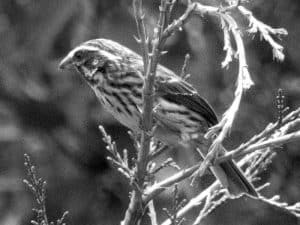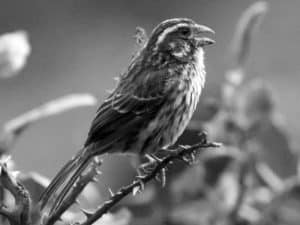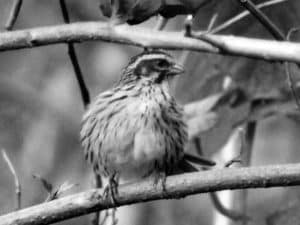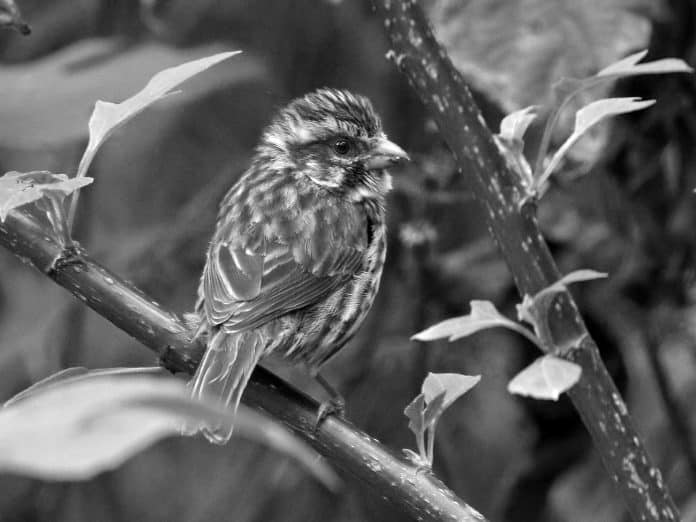Introduction to the streaky seedeater
The streaky seedeater, scientifically known as Crithagra striolata, is a small, sparrow-like bird that inhabits the lush forests and woodlands of Tanzania. This captivating species is a true gem for birdwatching enthusiasts, offering a unique and visually striking addition to any avian checklist. With its distinctive plumage and delightful behavior, the streaky seedeater in Tanzania has become a sought-after target for nature lovers and bird enthusiasts alike.

As you embark on your birdwatching adventure in Tanzania, prepare to be enchanted by the streaky seedeater’s charm and elegance. This article will guide you through the fascinating world of this remarkable bird, exploring its habitat, physical characteristics, and role in the ecosystem. We’ll also highlight the best birdwatching spots to spot the streaky seedeater, share tips for a successful sighting, and introduce you to the conservation efforts aimed at protecting this avian wonder.
Habitat and distribution of the streaky seedeater in Tanzania
The streaky seedeater is primarily found in the lush, verdant forests and woodlands of Tanzania, thriving in the country’s diverse and well-preserved natural habitats. These birds have a wide distribution throughout the region, with their range extending from the northern to the southern parts of the country.
One of the key factors contributing to the streaky seedeater’s prevalence in Tanzania is the abundance of their preferred food sources. These birds feed primarily on a variety of seeds, grains, and small insects, which are plentiful in the country’s rich and diverse ecosystems. The streaky seedeater’s adaptability to different forest types, from dense understories to more open canopies, has also allowed them to thrive in various parts of Tanzania.
To spot the streaky seedeater in its natural habitat, you’ll want to keep your eyes peeled in the following regions:
- Serengeti National Park
- Tarangire National Park
- Ruaha National Park
- Udzungwa Mountains National Park
- Kilimanjaro National Park
These protected areas offer prime birdwatching opportunities, with the streaky seedeater being a regular and captivating presence among the diverse avian species found in these renowned Tanzanian destinations.
Physical characteristics and behavior of the streaky seedeater
The streaky seedeater is a small, sparrow-like bird that boasts a distinctive and visually striking appearance. Its plumage is primarily a muted olive-brown color, with prominent streaks of dark brown or black running across its back, wings, and chest. This intricate pattern, combined with its small, conical beak and bright, attentive eyes, gives the streaky seedeater a unique and captivating look.
One of the most fascinating aspects of the streaky seedeater’s behavior is its social nature. These birds are often observed in small flocks, foraging and moving through the vegetation together. They exhibit a lively and energetic demeanor, hopping and flitting from branch to branch, constantly on the lookout for their next meal. The streaky seedeater’s cheerful, melodic calls can be heard echoing through the forest, adding to the enchanting ambiance of their natural habitat.
In addition to their social behavior, the streaky seedeater is also known for its adaptability and resilience. These birds have the ability to thrive in a variety of forest types, from dense understories to more open canopies, showcasing their impressive ability to navigate and exploit different environments.
As you observe the streaky seedeater in its natural habitat, you’ll be captivated by its graceful movements, its vibrant interactions with its flock mates, and its overall charm and charisma. This bird’s unique blend of physical attributes and behavioral traits make it a true delight for birdwatchers in Tanzania.
The role of the streaky seedeater in the ecosystem
The streaky seedeater plays a crucial role in the delicate balance of Tanzania’s forest ecosystems. As a seed-eating bird, it contributes to the dispersal and regeneration of various plant species, helping to maintain the diversity and health of the region’s vegetation.
By consuming a wide range of seeds and grains, the streaky seedeater helps to control the population of certain plant species, preventing any single species from dominating the ecosystem. This, in turn, supports the overall biodiversity of the forest, allowing for the coexistence of a rich and varied array of plant and animal life.
Furthermore, the streaky seedeater serves as an important food source for larger predatory birds and mammals within the ecosystem. Its presence in the food chain helps to sustain the intricate web of life that defines the lush, vibrant forests of Tanzania.
As a highly adaptable species, the streaky seedeater also plays a role in the resilience of these ecosystems. Its ability to thrive in a variety of forest types, from dense understories to more open canopies, makes it a valuable indicator of the overall health and resilience of the region’s natural habitats.
By understanding the crucial role the streaky seedeater plays in the delicate balance of Tanzania’s forest ecosystems, you can gain a deeper appreciation for the importance of conserving and protecting these remarkable birds and their habitats.
Popular birdwatching spots in Tanzania to observe the streaky seedeater

Tanzania is a true haven for birdwatchers, offering a diverse array of avian species, including the captivating streaky seedeater. As you plan your birdwatching adventure in the country, consider these popular and well-known spots to increase your chances of spotting this enchanting bird:
- Serengeti National Park: The vast, iconic Serengeti National Park is home to a rich diversity of bird life, including the streaky seedeater. The park’s diverse habitats, from open grasslands to dense woodlands, provide ample opportunities to observe these birds in their natural environment.
- Tarangire National Park: Known for its iconic baobab trees and diverse wildlife, Tarangire National Park is also a prime destination for birdwatchers. The park’s varied landscapes, including its lush riverine forests, are ideal for spotting the streaky seedeater.
- Udzungwa Mountains National Park: This stunning, biodiverse park in southern Tanzania is a hidden gem for birdwatchers. The Udzungwa Mountains are home to a wealth of avian species, including the streaky seedeater, which can be found in the park’s dense, montane forests.
- Kilimanjaro National Park: At the base of the majestic Mount Kilimanjaro, Kilimanjaro National Park offers a unique birdwatching experience. The park’s diverse habitats, from lush, montane forests to open, alpine meadows, provide opportunities to spot the streaky seedeater and other fascinating bird species.
- Ruaha National Park: As Tanzania’s largest national park, Ruaha is a birdwatching paradise. The park’s varied landscapes, including its iconic baobab-studded savannas and riverine forests, are home to the streaky seedeater and a host of other avian wonders.
By exploring these renowned birdwatching hotspots in Tanzania, you’ll increase your chances of encountering the streaky seedeater and adding this captivating bird to your avian checklist.
Tips for birdwatching the streaky seedeater in Tanzania
Birdwatching in Tanzania can be an incredibly rewarding experience, and the streaky seedeater is a prime target for enthusiasts. To ensure a successful and memorable sighting of this enchanting bird, consider the following tips:
- Timing is key: The best time to observe the streaky seedeater is during the early morning and late afternoon hours, when these birds are most active and vocal.
- Patience and stealth: Approach your birdwatching locations with patience and stealth, as the streaky seedeater can be elusive at times. Move slowly, keep your voice low, and be mindful of your surroundings to avoid startling the birds.
- Invest in quality optics: Equip yourself with high-quality binoculars and/or a spotting scope to get a closer, more detailed view of the streaky seedeater’s intricate plumage and behavior.
- Familiarize yourself with the call: Learn to recognize the streaky seedeater’s distinctive, melodic calls, which can help you locate and identify these birds in the field.
- Explore diverse habitats: While the streaky seedeater is primarily found in forested areas, be prepared to explore a variety of habitats, as these birds can also be spotted in more open, wooded environments.
- Join a guided tour: Consider booking a birdwatching tour with a local expert guide, who can provide invaluable insights and increase your chances of spotting the streaky seedeater and other rare bird species.
- Respect the environment: Always remember to practice responsible and eco-friendly birdwatching, avoiding any actions that may disturb or harm the birds or their habitats.
By following these tips, you’ll be well on your way to a successful and rewarding encounter with the streaky seedeater, further enhancing your birdwatching experience in the beautiful country of Tanzania.
Conservation efforts for the streaky seedeater
The streaky seedeater, despite its widespread distribution in Tanzania, is not immune to the threats that face many avian species worldwide. As a result, various conservation efforts have been implemented to ensure the long-term protection and preservation of this captivating bird.
One of the primary initiatives is the establishment of protected areas, such as national parks and nature reserves, which serve as safe havens for the streaky seedeater and other vulnerable species. These protected habitats provide the necessary resources and undisturbed environments for the birds to thrive, ensuring their continued presence in the region.
Additionally, ongoing research and monitoring programs have been crucial in understanding the streaky seedeater’s population dynamics, habitat preferences, and any potential threats to its survival. This data is then used to inform and guide conservation strategies, ensuring that the appropriate measures are taken to safeguard the species.
Local community engagement and education programs also play a vital role in the conservation of the streaky seedeater. By raising awareness and fostering a sense of stewardship among the people who live in close proximity to the bird’s habitat, these initiatives help to promote sustainable land-use practices and reduce any potential negative impacts on the species.
Furthermore, international organizations, such as BirdLife International and the IUCN, have recognized the importance of the streaky seedeater and have included it in their conservation efforts. These global initiatives help to raise awareness, secure funding, and coordinate cross-border collaborations to ensure the long-term survival of this captivating bird species.
As you embark on your birdwatching adventure in Tanzania, take a moment to appreciate the conservation efforts that have been put in place to protect the streaky seedeater. Your support, through responsible tourism and advocacy, can further contribute to the ongoing efforts to safeguard this enchanting avian wonder for generations to come.
Other bird species found in the same habitat as the streaky seedeater
The streaky seedeater is just one of the many fascinating bird species that can be found in the diverse habitats of Tanzania. As you explore the lush forests and woodlands in search of this captivating bird, you’ll have the opportunity to encounter a wide array of other avian wonders that share the same environment.
Some of the other notable bird species that can be observed alongside the streaky seedeater include:
- Superb Starling: A vibrant, iridescent bird with a striking blue and purple plumage, the superb starling is a common sight in the same habitats as the streaky seedeater.
- Lilac-breasted Roller: Known for its stunning, rainbow-like plumage, the lilac-breasted roller is a charismatic bird that can often be spotted in the same areas as the streaky seedeater.
- Silvery-cheeked Hornbill: This large, distinctive hornbill species is a true highlight for birdwatchers, and it can be found in the same forested environments as the streaky seedeater.
- Rufous-tailed Weaver: A vibrant, weaverbird species with a distinctive rufous-colored tail, the rufous-tailed weaver is another common companion to the streaky seedeater in Tanzania’s forests.
- African Paradise Flycatcher: With its long, flowing tail and iridescent plumage, the African paradise flycatcher is a true delight to observe in the same habitats as the streaky seedeater.
By keeping your eyes and ears open, you’ll have the opportunity to witness the rich diversity of bird life that coexists with the streaky seedeater, further enhancing your birdwatching experience in Tanzania.
Conclusion: The allure of the streaky seedeater for birdwatching enthusiasts in Tanzania

The streaky seedeater is a true gem for birdwatching enthusiasts in Tanzania, offering a unique and captivating addition to any avian checklist. With its distinctive plumage, delightful behavior, and vital role in the region’s ecosystems, this small, sparrow-like bird has captured the hearts and imaginations of nature lovers and bird enthusiasts alike.
As you explore the lush forests and woodlands of Tanzania, keep your eyes and ears open for the streaky seedeater’s presence. From the iconic Serengeti National Park to the hidden gems of the Udzungwa Mountains, these birds can be found in a variety of habitats, each offering a distinct and rewarding birdwatching experience.
By following the tips and insights shared in this article, you’ll be well on your way to a successful and memorable encounter with the streaky seedeater. Whether you’re a seasoned birdwatcher or a nature enthusiast seeking a new adventure, this captivating bird is sure to leave a lasting impression and ignite your passion for the wonders of Tanzania’s avian world.

































